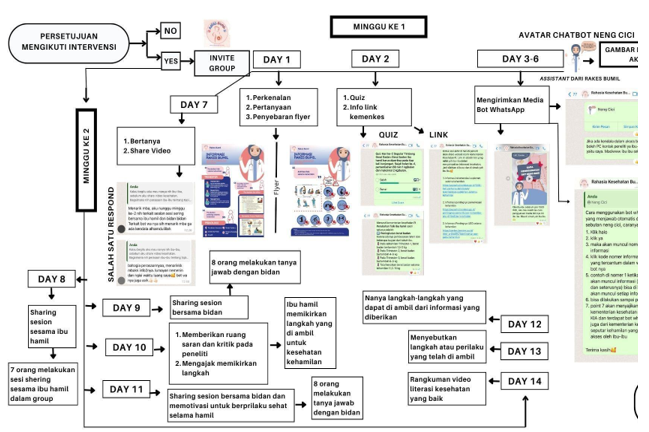Development and Implementation of WhatsApp-based Health Literacy Media for Pregnant Women (Rakes Bumil): A Community Empowerment Approach using ADDIE and AIDA Models
Main Article Content
Wulan Nurullinisa
Ratri Ciptaningtyas
Raihana Nadra Alkaff
Rahma Hida Nurrizka
Background: Pregnant women in urban areas are used to accessing digital information, but not all of it is easy to understand, especially for those with low health literacy. A survey in Bogor District showed that 27.5% of pregnant women have problematic literacy. WhatsApp, as a commonly used platform, has the potential to be an interactive educational media. Using the ADDIE stages and the AIDA strategy, the media was designed to deliver clear and engaging messages.
Aims: This study aims to develop and implement WhatsApp-based Rakes Bumil educational media with ADDIE stages and AIDA strategies to deliver accurate and interesting health information, to encourage an increase in the health literacy of pregnant women, especially in the aspects of knowledge, search, assessment, and decision making related to pregnancy health information.
Methods: This study uses a quantitative approach with participatory action research design for content validation and development, implementation of Rakes Bumil educational media following the ADDIE model and AIDA strategy.
Result: The media was developed through ADDIE stages, in Rakes Bumil there are ChatBot media, flyers, animated videos, and interactive quizzes. The feasibility test results show that the media is well received by pregnant women, with >90% of pregnant women stating that the media is feasible to use to support pregnancy literacy. The 14-day implementation showed an increase in engagement and understanding of health information. These findings form the initial basis for further research that will quantitatively evaluate the effectiveness of the media.
Akbarinejad, F., Soleymani, M. R., & Shahrzadi, L. (2017). The relationship between media literacy and health literacy among pregnant women in health centers of Isfahan. Journal of education and health promotion, 6(1), 17-page.https://doi.org/10.4103/2277-9531.204749
Alhuwail, D. And Abdulsalam, Y., (2019). Assessing Electronic Health Literacy In The State Of Kuwait: Survey Of Internet Users From An Arab State. Journal Of Medical Internet Research, 21(5), P.E11174. https://doi.org/10.2196/11174.
Arifah, I., Pambarep, T. S. A., Khoiriyah, L., Kusumaningrum, T. A. I., Werdani, K. E., & Ngadiyono, N. P. (2023). Effectiveness of daily educational message on pregnancy anemia prevention behavior and knowledge: A pilot randomized controlled trial. Journal of Education and Health Promotion, 12(1), 296. https://doi.org/10.4103/jehp.jehp_108_23.
Chen, S., Yue, W., Han, X., Luo, J., Na, L., & Yang, M. (2022). An integrative review on the maternal health literacy among maternal and child workers. Journal of Nursing Management, 30(8), 4533-4548. https://doi.org/10.1111/jonm.13830.
Damayanti, N. A., Wulandari, R. D., Ridlo, I. A., Kusniar, N. A. C., & Pangastuti, A. (2022). The Internet As A Health Information In Decision Making Of Pregnant Women. Indonesian Journal of Health Administration, 10(1), 79-88. https://doi.org/10.20473/jaki.v10i1.2022.79-88.
Danaei, A., & Sanei, N. S. (2019). The effect of health-related messages on the behavior of social network audiences according to attention, interest, desire, action model. Journal of Research and Health, 9(6), 525-532. https://doi.org/10.32598/jrh.9.6.525.
Elsharkawy, N. B., Abdelaziz, E. M., Ouda, M. M., & Oraby, F. A. (2022). Effectiveness of health information package program on knowledge and compliance among pregnant women with anemia: a randomized controlled trial. International Journal of Environmental Research and Public Health, 19(5), 2724. https://doi.org/10.3390/ijerph19052724.
Ernawati, I., & Sukardiyono, T. (2017). Uji kelayakan media pembelajaran interaktif pada mata pelajaran administrasi server. Elinvo (Electronics, Informatics, and Vocational Education), 2(2), 204-210.
Fasimi, R. H., Hapsari, E. D., & Widyawati, W. (2020). Pengaruh Media Edukasi via Whatsapp Group terhadap Pengetahuan Ibu tentang Tanda dan Gejala Preeklampsia. Jurnal Keperawatan Klinis dan Komunitas (Clinical and Community Nursing Journal), 4(1), 36-43.
Feine, J., Morana, S., & Maedche, A. (2020). Designing Interactive Chatbot Development Systems. In ICIS.
Glowalla, U., & Hasebrook, J. (1995). An Evaluation Model Based on Experimental Methods Applied to the Design of Hypermedia User Interfaces. , 99-116. https://doi.org/10.1007/978-3-642-45743-2_11.
Javanmardi, M., Noroozi, M., Mostafavi, F., & Ashrafi-Rizi, H. (2018). Internet usage among pregnant women for seeking health information: a review article. Iranian journal of nursing and midwifery research, 23(2), 79-86. https://doi.org/10.4103/ijnmr.IJNMR_82_17.
Javanmardi, M., Noroozi, M., Mostafavi, F., & Ashrafi-Rizi, H. (2020). Exploring women’s Health information needs during pregnancy: A qualitative study. Journal of Family & Reproductive Health, 14(4), 252. https://doi.org/10.18502/jfrh.v14i4.5209.
Kotler, P., & Keller, K. L. (2007). Manajemen Pemasaran Edisi 13 Jilid 2. Jakarta: Erlangga.
Kusyanti, T., Wirakusumah, F. F., Rinawan, F. R., Muhith, A., Purbasari, A., Mawardi, F., Puspitasari, I. W., Faza, A., & Stellata, A. G. (2022). Technology-Based (Mhealth) and Standard/Traditional Maternal Care for Pregnant Woman: A Systematic Literature Review. In Healthcare (Switzerland) (Vol. 10, Issue 7). MDPI. https://doi.org/10.3390/healthcare10071287
Leithwood, K. A., & Montgomery, D. J. (1980). Evaluating program implementation. Evaluation review, 4(2), 193-214. https://doi.org/10.1177/0193841X8000400202.
Lestari, N. P. (2023). Preliminary Research: Development of A Teaching Module Based on Problem Based Learning To Improve Students' Mathematical LiteracyAbilities. Mathline: Jurnal Matematika dan Pendidikan Matematika, 8(4), 1487-1506. https://doi.org/10.31943/mathline.v8i4.539.
Liberman, J. S., Shenoy, A. K., Sullenberger, L., Abshire, G., & Owens, B. (2016). Virginia Mason Medical Center, Seattle, WAThe “Silent” Disparity-Health Literacy: Enhancing Provider Awareness. Ochsner Journal, 16(Spec AIAMC Iss), 47-48.
Lupton, D. (2016). The use and value of digital media for information about pregnancy and early motherhood: a focus group study. BMC pregnancy and childbirth, 16(issue), 1-10. https://doi.org/10.1186/s12884-016-0971-3.
Levin-Zamir, D., & Bertschi, I. (2018). Media health literacy, eHealth literacy, and the role of the social environment in context. International journal of environmental research and public health, 15(8), 1643.https://doi.org/10.3390/ijerph15081643.
Montenegro, J. L. Z., da Costa, C. A., & Janssen, L. P. (2022). Evaluating the use of chatbot during pregnancy: A usability study. Healthcare Analytics, 2, 100072. https://doi.org/10.1016/j.health.2022.100072
Mulyani, E. Y., Jus’at, I., & Sumaedi, S. (2023). The effect of Augmented-Reality media-based health education on healthy lifestyle knowledge, attitude, and healthy lifestyle behaviors among pregnant women during COVID-19 pandemic in Jakarta, Indonesia. Digital Health, 9. https://doi.org/10.1177/20552076231167255
Nawabi, F., Krebs, F., Vennedey, V., Shukri, A., Lorenz, L., & Stock, S. (2021). Health literacy in pregnant women: a systematic review. International journal of environmental research and public health, 18(7), 3847. https://doi.org/10.3390/ijerph18073847
Neves Dutra, I., & Bértolo Ferreira, M. H. (2023). Internet as a source of information and health literacy in pregnancy: a scoping review. Pensar Enfermagem, 27(1).
Ningrum, E. W., Lusmilasari, L., Huriyati, E., Marthias, T., & Hasanbasri, M. (2024). Improving maternal health literacy among low-income pregnant women: A systematic review. Narra J, 4(2). http://doi.org/10.52225/narra.v4i2.886
Nurdiansyah, Y., & Jayanto, A. D. (2021, December). Pengukuran kesiapan pengguna aplikasi face to face polsek semboro menggunakan metode TRI (Technology Readiness Index). In Prosiding Seminar Nasional Sains Teknologi dan Inovasi Indonesia (SENASTINDO) (pp. 135-144).
Omole, O., Ijadunola, M. Y., Olotu, E., Omotoso, O., Bello, B., Awoniran, O., ... & Fatusi, A. (2018). The effect of mobile phone short message service on maternal health in south‐west Nigeria. The International journal of health planning and management, 33(1), 155-170. https://doi.org/10.1002/hpm.2404
Polk, X. L. (2018). Marketing: The key to successful teaching and learning. Journal of Marketing Development and Competitiveness, 12(2). https://doi.org/10.33423/jmdc.v12i2.1257.
Rahdar, S., Montazeri, M., Mirzaee, M., & Ahmadian, L. (2023). The relationship between e-health literacy and information technology acceptance, and the willingness to share personal and health information among pregnant women. International Journal of Medical Informatics, 178, 105203.
Rangga, H. (2022). Model Aida (Attention, Interest, Desire, Action) Sebagai Strategi Pemasaran Online Di Masa Pandemi Covid-19 (Studi Kasus: Toko Shenaz Fashion). Jurnal Teknologi Terkini, 2(11).
Ranuharja, F., Ganefri, G., Fajri, B. R., Prasetya, F., & Samala, A. D. (2021). Development of interactive learning media edugame using ADDIE model. Jurnal Teknologi Informasi Dan Pendidikan, 14(1), 53-59. https://doi.org/10.24036/TIP.V14I1.412.
Romadhoni, A. P. (2022). Analisis Penerapan Strategi Attention, Interest, Desire dan Action pada Aplikasi Layanan Pospay. Jurnal Ekobistek, 11(4), 315-322. https://doi.org/10.35134/ekobistek.v11i4.426.
Slocumb, E. M., & Cole, F. L. (1991). A practical approach to content validation. Applied Nursing Research, 4(4), 192-195. https://doi.org/10.1016/S0897-1897(05)80097-7.
Sørensen, K., Van den Broucke, S., Fullam, J., Doyle, G., Pelikan, J., Slonska, Z., ... & (HLS-EU) Consortium Health Literacy Project European. (2012). Health literacy and public health: a systematic review and integration of definitions and models. BMC public health, 12, 1-13. https://doi.org/10.1186/1471-2458-12-80.
Sugihartini, N., & Yudiana, K. (2018). ADDIE Sebagai Model Pengembangan Media Instruksional Edukatif (MIE) Mata Kuliah Kurikulum Dan Pengajaran. Jurnal Pendidikan Teknologi Dan Kejuruan, 15(2). https://doi.org/10.23887/JPTK-UNDIKSHA.V15I2.14892.
Taheri, S., Tavousi, M., Momenimovahed, Z., Direkvand, Moghadam, A., Tiznobaik, A., Suhrabi, Z., & Taghizadeh, Z. (2020). Development And Psychometric Properties Of Maternal Health Literacy Inventory In Pregnancy. Plos One, 15(6), E0234305. https://doi.org/10.1371/journal.pone.0234305.
Utari, S. A., & Zebua, W. D. A. (2020, May). Health Communication Through Online Media, The Using Of Digital Pregnancy Applications As An Alternative Information Source For The Millennial Mothers In Indonesia. In Proceeding of International Conference on Social Sciences (pp. 25-33). https://doi.org/10.4108/eai.5-11-2019.2292525.
Vamos, C. A., Merrell, L., Detman, L., Louis, J., & Daley, E. (2019). Exploring women's experiences in accessing, understanding, appraising, and applying health information during pregnancy. Journal of midwifery & women's health, 64(4), 472-480.
Wulan Nurullinisa , UIN Syarif Hidayatullah Jakarta, Indonesia
Fakultas Ilmu Kesehatan, UIN Syarif Hidayatullah Jakarta, Kota Tangerang Selatan, Banten, Indonesia
Ratri Ciptaningtyas , UIN Syarif Hidayatullah Jakarta, Indonesia
Fakultas Ilmu Kesehatan, UIN Syarif Hidayatullah Jakarta, Kota Tangerang Selatan, Banten, Indonesia
Raihana Nadra Alkaff , UIN Syarif Hidayatullah Jakarta, Indonesia
Fakultas Ilmu Kesehatan, UIN Syarif Hidayatullah Jakarta, Kota Tangerang Selatan, Banten, Indonesia
Rahma Hida Nurrizka , UIN Syarif Hidayatullah Jakarta, Indonesia
Fakultas Ilmu Kesehatan, UIN Syarif Hidayatullah Jakarta, Kota Tangerang Selatan, Banten, Indonesia








